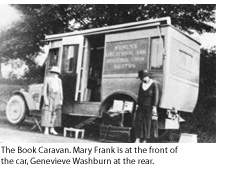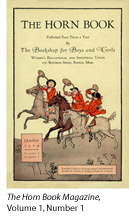A Little History of The Horn Book Magazine
This promotional pamphlet was written by Karen Jameyson in the 1980s and later updated by the Horn Book.
Beginnings
 Back in the early 1920s, before the ink of the first Horn Book Magazine was even dry on the page, the Boston YMCA announced a course in automobiles and engines. At a time when cars were still a luxury, female drivers caused heads to swivel, and courses in automobile mechanics were practically on a par with today’s skydiving instruction, Frances Darling, a young children’s librarian, signed up.
Back in the early 1920s, before the ink of the first Horn Book Magazine was even dry on the page, the Boston YMCA announced a course in automobiles and engines. At a time when cars were still a luxury, female drivers caused heads to swivel, and courses in automobile mechanics were practically on a par with today’s skydiving instruction, Frances Darling, a young children’s librarian, signed up.
Although cranks and axle grease were a remote cry from well-ordered shelves of children’s books, little time passed before the tall, dignified librarian could poke and prod knowledgeably among cylinders and tubes — a good thing, too, for she would not be idly tootling around the city. She had mastered the intricacies of the automobile for very serious reasons.
 Frances Darling also worked at a small bookstore. Tucked away from the bustle of downtown, across from the Public Garden with its serene-looking swan boats, The Bookshop for Boys and Girls welcomed patrons with comfortable chairs, glowing fires, and shelf after shelf of the finest children’s books available. The mastermind behind it all, the diminutive but tirelessly energetic Bertha Mahony, saw to it that her customers were well served. Ever since the store had first opened its doors in 1916 it had flourished under her informed, ebullient leadership. Now, impatient as usual, Bertha was craning her neck to see beyond the Boston area, to reach a wider public with good books. She finally engineered a deal with a number of publishers and the Women’s Educational and Industrial Union to underwrite costs for a book caravan, actually a rebuilt truck, fondly dubbed “William” by its drivers, that would travel around the countryside.
Frances Darling also worked at a small bookstore. Tucked away from the bustle of downtown, across from the Public Garden with its serene-looking swan boats, The Bookshop for Boys and Girls welcomed patrons with comfortable chairs, glowing fires, and shelf after shelf of the finest children’s books available. The mastermind behind it all, the diminutive but tirelessly energetic Bertha Mahony, saw to it that her customers were well served. Ever since the store had first opened its doors in 1916 it had flourished under her informed, ebullient leadership. Now, impatient as usual, Bertha was craning her neck to see beyond the Boston area, to reach a wider public with good books. She finally engineered a deal with a number of publishers and the Women’s Educational and Industrial Union to underwrite costs for a book caravan, actually a rebuilt truck, fondly dubbed “William” by its drivers, that would travel around the countryside.
The first year the book caravan operated it made forty-nine scheduled book stops but also just about as many unscheduled stops for flat tires, mechanical catastrophes, and muddy, unpredictable New England roads — the forerunners of today’s highway system. So for the second year, when Bertha wanted technical wisdom as well as book knowledge aboard, Frances Darling — fresh from her course at the Y — slid behind the wheel. She shared the driving with another automotively literate librarian, and while the caravan was still beset with flat tires, the two women changed them with little disruption.
Although William was retired the following year for financial reasons, the bookmobile that had sputtered into so many remote New England towns left its mark, stimulating the development of bookmobile service during the years to come.
 |
| Bertha Mahony Miller in 1929 |
Spreading the word: The Horn Book Magazine begins
Bertha Mahony, never one to sit around drumming her fingers, knew that she must somehow find new ways to let people know about good books. In her own shop this tidy, bright-eyed bookseller seemed to be everywhere at once, directing children, parents, librarians, writers, teachers, customers, artists, editors, and others to this or that title. Her staff was instructed to read, read, read. She organized programs and displays and, taking a deep breath, gingerly ventured beyond New England to meet others involved in the budding young field of children’s books. That was only the beginning. Bertha was to become one of the true pioneers in the field of children’s literature. In 1924 she accomplished the equivalent of building a sod house in the wilds of Minnesota: with her colleague Elinor Whitney Field, she founded the first magazine anywhere to concern itself exclusively with children’s books and reading.
The Horn Book Magazine evolved partly as an effort to catalogue the hoopla and bibliophilistic cheer that vibrated the shelves in The Bookshop for Boys and Girls. In fact, so carried away with excitement were Bertha and Elinor Whitney Field about recording events in the magazine that they actually forgot to print the price on the first issue. But the magazine’s main purpose was, as Bertha stated emphatically at the beginning of Volume I, Number 1, “to blow the horn for fine books for boys and girls.” For many years Randolph Caldecott’s three jovial huntsmen pranced across the cover of the magazine, tooting their own tiny horns to underscore Bertha’s edict. And for more than seventy-five years the magazine really has been blowing the horn, although the notes have sounded different tunes throughout the seven decades. “Make the magazine reflect the times,” Bertha entreated the editors who would succeed her, and in one way or other that’s what they have attempted to do.
 Contributors and philosophy: The early days
Contributors and philosophy: The early days
Bertha flagged down the leaders in the field, and gradually the magazine’s seemingly all-star cast of regular or frequent contributors included Louise Seaman Bechtel, who stepped into the first editorship of children’s books ever at Macmillan in 1918; the editor May Massee of Viking; Alice Jordan, for so many years in charge of children’s services at the Boston Public Library; the opinionated Anne Carroll Moore, director of Work with Children at the New York Public Library; and her successor, Frances Clarke Sayers.
As Bertha’s articles demonstrated, as her plain-spoken yet eloquent editorials exemplified, she was ever aware of and responsive to the nuances of the children’s literature community. But she also kept her eye on the barometer of humanity. There she was — heading a relatively new magazine during the unsteady days of the Depression and during the turbulent years of World War II. Articles revealing the effects of war on children in battle-torn countries appeared in the magazine. Bertha’s tendency, however, was not to bog down her issues with the devastation of war but to pay tribute to the unflagging spirits of the strugglers, the survivors. This wise plucky woman, resourceful editor, and master engineer gave The Horn Book the firm foundation — a sure, vital commitment to good literature — that would support the magazine through future decades yet still allow its subsequent editors to remain sensitive to the fluctuations in the world of children’s books.
Bertha’s successors
When Jennie Lindquist, formerly managing editor of The Horn Book, became editor in 1951, she was face to face with a children’s book publishing industry creating a greater variety of books than ever before. She skillfully kept the magazine on course under this onslaught of titles — plumping up the issues and allowing the reviews to grow a bit longer and occasionally more controversial.
As the third editor, Ruth Hill Viguers, took over the magazine in 1958, The Horn Book — which had been sailing right along with the stable, dependable breezes generated by the publishing and library communities — hit stormy seas. Social realism in books for the young was here, as were the heated arguments concerning it, and the magazine reflected the tempest. In addition to writing provocative editorials on that and other subjects, Ruth Viguers stirred up the readership by publishing Frances Clarke Sayers’s passionate “Walt Disney Accused.”
Paul Heins, Horn Book editor between 1967 and 1974, brought an extensive literary background and substantial teaching experience to an editorship rich in both intellectual and international concerns. He also refereed what was possibly the most heated controversy ever to appear in the pages of the magazine: a knock-down, drag-out verbal duel between critic Eleanor Cameron and author Roald Dahl.
Immediately after the bulging, bountiful fiftieth anniversary issue, Ethel L. Heins, a long-time reviewer and an experienced librarian, took over the magazine. Her emphasis on the importance of looking both forward to the best new books and backward to the gems of the past, through features such as “A Second Look” and “Out of Print — But Look in Your Library,” added yet another dimension to the magazine.
In 1985, when Anita Silvey became the sixth editor of the magazine, she came armed with years of valuable publishing experience, and her keen perception of the children’s book world sent varied flags up the masthead. “It is my hope,” she stated, “that the pages of this magazine . . . will reflect the entire children’s book community.” New columns and features included “A Publisher’s Perspective,” “Young Adult Books,” and “Books in the Classroom,” to name a few. In 1989, Ms. Silvey launched a new publication, The Horn Book Guide.
Native New Englander Roger Sutton returned home in 1996 to become the current editor of the Horn Book. Known for his ready wit and eagerness to join a good battle, he began his career as a children's librarian in Chicago, gained fame as a reviewer and frequent contributor to journals, and then served for several years as editor of The Bulletin of the Center for Children's Books. Under his tenure the magazine has increased its attention to non-print media, paperbacks, and international publishing.
The Horn Book Magazine Today
Voices change; they should change and modulate with the times. As Bertha knew, “A magazine devoted to books must always consider ways of keeping its character vital and fresh.” There is, for example, no longer a maid listed on the masthead as there was in the earliest magazines. (Nor is there, in fact, any longer a maid!) But there are some aspects that shouldn’t fluctuate. As Ann Durrell pointed out in the December 1974 issue, “A good yardstick does not change its measurements from year to year.” Circumstances change; criteria change; standards need to be upheld.
New, old, familiar, and diverse voices blend in the magazine, but behind them all there is one tune that keeps playing. Regardless of how the magazine listens and responds to the children’s literature community, that is one sound that has not faded. More than ninety years after its first publication, The Horn Book Magazine is still blowing the horn for the finest books for boys and girls.
RELATED
ALREADY A SUBSCRIBER? LOG IN
We are currently offering this content for free. Sign up now to activate your personal profile, where you can save articles for future viewing.







Add Comment :-
Be the first reader to comment.
Comment Policy:
Comment should not be empty !!!